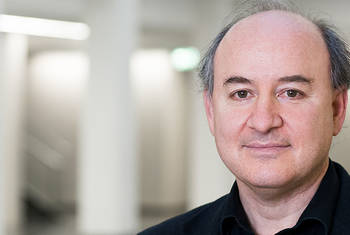Matthew Larkum What is Memory and How Does it Function at the Cellular Level?
Matthew Larkum has been Professor of Neurobiology at Humboldt-Universität zu Berlin since 2011. He previously worked at the Max Planck Institute for Medical Research and at the University of Bern where he completed his PhD. Larkum’s research focuses on the functioning of the cerebral cortex and asks questions like what makes us intelligent or how does conscious perception work? Having published a line of highly influential papers in journals like Cell, Science and Nature Neuroscience, Larkum’s work has been supported by the Human Brain Project (HBP), European Research Council (ERC) Horizon 2020, Einstein Center Neurosciences (ECN) and Deutsche Forschungsgemeinschaft (DFG). He received the Robert Bing Prize from the Swiss Academy of Medical Sciences in 2010
Area of Research
Neurobiology
since 2018
Speaker
Mechanisms and disturbances in memory consolidation: from synapses to systems
since 2011
Full Professor
Humboldt University of Berlin (Humboldt-Universität zu Berlin) (more details)
Dept. of Neurobiology
2004-2011
SNSF Professor
University of Bern (Universität Bern)
Institute of Physiology
1997-2003
Postdoctoral Fellow
Max Planck Institute for Medical Research, Heidelberg
1992-1996
Ph.D.
University of Bern (Universität Bern)
Institute of Physiology, Supervisor: Hans-Rudolf Lüscher
1991
First Class Honours in Physiology
The University of Sydney
Supervisor: Max Bennett
1987-1990
Bachelor of Science
The University of Sydney
Prizes
- Robert Bing Prize, Swiss Academy of Medical Sciences (2010)
- Pfizer Prize for the best neuroscience paper published by a Swiss group (2007)
- Theodor Kocher Prize (2006)
Fellowships
- Nikon Research Fellowship, Woods Hole Research Laboratories (2003)
- Woods Hole Research Fellowship (2002)
- Max Planck Society Scholarship (1999-2001)
- Alexander von Humboldt Scholarship (1997-1999)
- Australian Postgraduate Research Award (1992-1995)
- Human Brain Project (HBP)
- European Research Council (ERC)
- Einstein Center Neurosciences (ECN)
- Horizon 2020
- Deutsche Forschungsgemeinschaft (DFG)
- ERC program grant (2016)
 © Heike Zappe/ HU Berlin
© Heike Zappe/ HU Berlin

Humboldt University of Berlin (Humboldt-Universität zu Berlin)
BerlinIn 1810, Wilhelm von Humboldt’s idea of founding a new type of university became a reality. The combination of teaching and research, academic freedom and the comprehensive education of students was not only a model for the Prussian university but for the world as well. And a new era for universities and academic research began. Each year, over 6,000 people decide to study at Humboldt-Universität located in the heart of Berlin. There are few other places where you can choose from 190 degree programmes, from Agricultural Science to Asian Studies. The university is first and foremost dedicated to fundamental research. Humboldt-Universität’s strengths in particular are in research on antiquity, history, philosophy, and quantitative economics as well as the life sciences, especially theoretical biology, neurology and immunology. It also has strengths in mathematics, material and optical sciences, and climate and sustainability research. These key strengths are shaped by twelve collaborative research areas, nine graduate research clusters and eleven interdisciplinary centres. Three integrated research institutes strongly connect and coordinate different research areas while developing focused topics for the future. (Source: Humboldt-Universität zu Berlin)
Institute
SFB 1315
The SFB 1315 "Mechanisms and disturbances in memory consolidation: from synapses to systems" is a DFG funded Humboldt University project.
Map
Vital steps have been taken in recent years in our understanding of how the cerebral cortex functions at the cellular level. In this video, MATTHEW LARKUM analyzes the role that memory plays in this context. Employing techniques including electrical and optical recordings as well as chemogenetics in experiments with live animals, Larkum’s lab has demonstrated that the medial temporal lobe projects to layer one of the neocortex and that this is central to the ability to learn. With several subsidiary findings casting further light on how memory functions, Larkum’s groundbreaking research promises to continue to reveal secrets about what occurs during memory storage at the cellular level.
LT Video Publication DOI: https://doi.org/10.21036/LTPUB10894
Perirhinal Input to Neocortical Layer 1 Controls Learning
- Guy Doron, Jiyun N. Shin, Naoya Takahashi, Moritz Drüke, Christina Bocklisch, Salina Skenderi, Lisa de Mont, Maria Toumazou, Julia Ledderose, Michael Brecht, Richard Naud and Matthew E. Larkum
- Science
- Published in 2020









